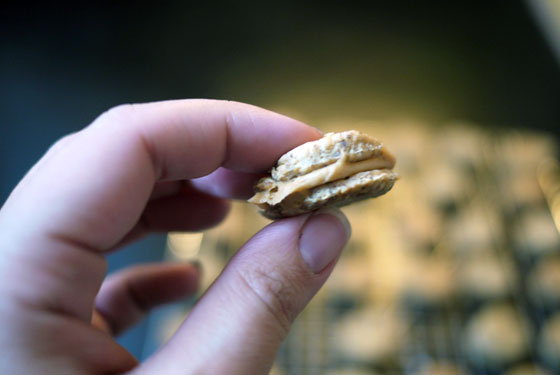Power is going to come up a lot, so it’s worthwhile to think about a bit. One of the ways that I am interested in how activist art manifests is against, alongside, parallel to, and in opposition to P/power. But how does it work?
 Chomp, Chomp
Chomp, Chomp
A mental exercise: Imagine a delicious cracker sandwich, made with lots of peanut butter or hummous [and whatever else you like]. Take a bite of this snack: what happens?
The top cracker presses down and the bottom cracker presses up and the peanut butter or hummous squeezes out the sides.
This is how power works. Oppression pushes down, resistance pushes back, and meanwhile something unexpected comes out somewhere hard to determine beforehand. Sometimes the hummous just gets your hand messy, and sometimes you have peanut buttery crumbs on your lap that you accidentally grind into your skirt [or is that just me?].
The point is that what squeezes out the side is not automatically awesome – though it could be. Rather, what comes out the sides is free from both the top [oppressive] and bottom [resistant] crackers, but is related to the motions of both. No snacking, no squeezing.
Diffuse Power
The concept of “power†was transformed in praxis by Marx [collective action is material power] and theoretically by Foucalt [since power is dispersed and diffuse, everyone participates in power and therefore has power], and is a subject of so much discussion and debate that I can really only touch on it here.
The important ideas to hold onto are:
-Â Â Â Â Â Â everyone has some power, although some people have easy access to more than others
-      not everyone experiences or notices that they have power [but don’t assume that people are disempowered]
-      power works by making itself invisible and seeming normal [Foucalt’s idea of self-policing, or Boal’s cop-in-your-head]
This leads us to think about how power has changed according to the tools of domination and oppression available. At the same time, these tools are used by folks who are not “in power.†If resistance just before the age of digital networks looked like WAC, DAM!, ACT-UP, Gran Fury and more, then resistance in a digital age looks like the power that it purports to resist: both the tools to use and the oppressions being fought are of a new form.
